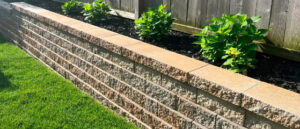What Is a Retaining Wall?
Retaining Wall is a structure used for holding back soil. Lateral earth pressures build up against walls and can push or overturn them if not properly addressed. Besides being problem solvers, retaining walls are attractive and can enhance the landscape. They come in a variety of materials that evoke different styles.
Sheet pile retaining walls are formed of sections of sheet material with interlocking edges and are driven into the ground to provide earth retention and excavation support. These structures are typically made of steel but can also be formed of timber and reinforced concrete. They are used in a range of applications, including construction of waterfront structures such as wharves and quays, diversion dams such as cofferdams, and seawalls. They are also used for environmental barrier walls and to retain soil in cut off areas.
Unlike conventional masonry wall construction, which takes days to cure after each pouring activity, the installation of a sheet pile retaining wall can be completed in much less time. This means that construction can continue at a quicker rate and the risk of delays due to weather conditions is minimised. In addition, sheet piling is also considerably lighter than concrete, which reduces transportation costs. This means that the risks of damage and deterioration during transport are minimised, and issues pertaining to material quality are kept to an absolute minimum.
A key advantage of steel sheet piles is that they are impenetrable to water, providing a high level of protection against seepage. However, this is only true if the appropriate protective measures are implemented, such as clutch sealants, which ensure that any gaps in the interlocking mechanism are sealed. This ensures that the water ingress is prevented at the most critical points, which will ultimately determine the performance of the retaining wall.
There are several types of sheet pile, with the most common being Z-shaped and U-shaped. The former has indentations or troughs along its length which increase its resistance to bending, while the latter has a straight web section and is therefore better suited for lateral applications. Larssen sheet pile is another option, which consists of narrow segments with alternating indents and outdents that help to resist lateral loads.
When constructing a retaining wall using sheet piles, it is important to consider the internal forces which will act on the structure, such as bending moments and shear forces. These must be determined for the specific design configuration. The stiffness of the retaining wall and soil, method of construction and initial stresses in the soil are all taken into account to determine the load magnitudes and displacements. The bending moments and shear forces can then be calculated either using advanced analytical methods or simplistically by applying the Peck envelope method or deformation methods.
It is often preferable to use a top-down approach when building a retaining wall, as this can reduce the amount of vertical soil movement. This can be achieved by constructing a stiff concrete floor at ground level and then propping the piles above this. However, this method can be expensive, and may not be practical in some circumstances.
Depending on the design specifications, the lateral stability of a retaining wall constructed from steel sheet piles can be limited by limiting its height, or by incorporating internal reinforcement in order to prevent excessive bending deflections. In some cases, it is necessary to use a combination of both methods in order to guarantee the required structural integrity.
Raft
A retaining wall holds back and stabilizes a sloping area of land. It helps add usable space to a property, correct grading issues, prevent erosion and more. A retaining wall can be constructed from a wide variety of materials including concrete, bricks, wood and more. Each type of retaining wall offers different advantages depending on your goals and budget.
A concrete retaining wall is generally the most cost effective. It’s also the most durable and will last for decades. It can be made from precast forms or poured on site. If you’re looking for a more unique look, try a brick retaining wall. Brick is a time-honored material that has been used in building for centuries and can provide a beautiful accent to any landscape design.
Another popular choice is a timber retaining wall. It’s a more natural material that can blend well with many styles of landscaping. However, it’s important to keep in mind that this type of retaining wall is not as stable as other options and may require more frequent maintenance.
An anchored retaining wall is a specialized style that uses cables or other stays to hold the soil in place. This method is especially useful in steep slopes that cannot be easily graded or in situations where soil stability is a concern. An anchored wall is more expensive than other types of retaining walls but it’s well worth the investment for projects that require extreme lateral earth pressure.
If you’re planning to build a retaining wall, it’s essential to consult with a professional. If your project will involve a retaining wall higher than 3 feet or will affect a significant amount of runoff, you will need to have a professional engineer review and approve the plans before construction begins. You will also need to review local codes, determine the type of soil (organic or dense), climate and drainage patterns before construction begins. In addition, you will need to install a perforated drain pipe behind your retaining wall before backfilling to reduce the hydrostatic pressure created by water and to avoid failure of your retaining structure.
To construct a retaining wall, you’ll need to lay a base of crushed stone or other durable material. Use a carpenter’s level to ensure the base is perfectly flat and straight. Then, begin laying blocks, starting with the first course. It’s essential to make sure that each block is evenly stacked and aligned left-to-right and front-to-back.
Once the foundation is in place, you can finish your retaining wall with decorative rock, planters or other accents. You can also choose to landscape your retaining wall to complement the surrounding landscape and home. For example, you can add a staircase to the rear of your retaining wall to create an outdoor living area or terrace your hillside for eye-catching flower beds.
A well-designed and properly built retaining wall can transform your landscape and increase the value of your property. Contact Clients First Landscapes to discuss your options for a retaining wall that will meet your needs and budget.

